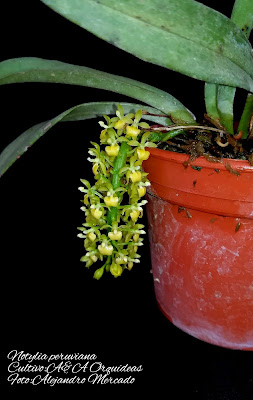Notylia peruviana is native to Bolivia, Ecuador, Peru and Venezuela. In Bolivia, these plants were encountered at a height of about 230 m near Riberalta, in the north-easternmost part of this country...
Notylia peruviana also called as The Peruvian Notylia, Dipteranthus peruvianus, Notylia boliviensis, is a species of the genus Notylia. This species was described by Charles Schweinfurth in 1946.
IDENTIFY NOTYLIA PERUVIANA
Notylia peruviana is native to Bolivia, Ecuador, Peru and Venezuela. In Bolivia, these plants were encountered at a height of about 230 m near Riberalta, in the north-easternmost part of this country. In Ecuador they grow in damp mountain forests, and they were encountered in the Province of Morona-Santiago at an altitude of 900-1000 m, in the Province of Napo near Jatun Sacha at an altitude of 450 m, between Tena and Puyo, and at Río Aquarico near Sancudo at an altitude of 235 m. In Peru, they were encountered in the department of Loreto near Yanamono at 130 m and in the department of Madre de Dios at an altitude of 200 m. In Venezuela, they were encountered in the south-western part of the state of Bolívar along the Rio Cuchimi near its connection with Río Erebato on height 700-910 m.
It is a small sized, hot to warm growing, twig epiphyte, which reaching a height of 18 cm, that has inconspicuous, ovoid, 1.3-1.5 cm long pseudobulbs carrying single, straight, leathery leaf with a ribbon shape that blunts the tip, up to 18 cm long and 2 cm wide leaves.
The Peruvian Notylia blooms from spring to summer with a up to 25 cm long, pendant, racemose inflorescence that carrying a lot of flowers in the inflorescence. The flowers are quite loosely distributed on the floral shoot for the greater part of its length. The petals of both whorls are pale yellow to greenish-yellow, the lip is yellow, and the prone and white anther chamber.
NOTYLIA PERUVIANA CARE AND CULTURE
Cultural information should only be used as a guide, and should be to be adapted to suit you. Your physical location; where you grow your plants, how much time you have to devote to their care, and many other factors, will need to be taken into account. Only then can you decide on the cultural methods that best suit you and your plants.
Light:
Notylia peruviana needs a light level of 12000-20000 lux.
Temperature:
Throughout the year, the average day temperature is 27-29 ° C, the night 18-19 ° C, which gives a daily difference of 9-11 ° C.
Humidity:
The Peruvian Notylia needs the humidity is 85-90% throughout the year.
Substrate, growing media and repotting:
It is best to grow Notylia peruviana mounted on tree ferns or cork, and those grown in pots require a loose substrate.
Watering:
In the natural habitat, rainfall is very abundant throughout the year. The cultivated plants should be abundantly watered, but excellent drainage must be ensured.
Fertilizer:
Weekly use of 1/4-1/2 of the recommended dose of orchid fertilizer is recommended.
Rest period:
In winter, Notylia peruviana need less water, especially when they are not in active growth and when grown on a short, dark day at moderate latitudes, but they can never dry up completely. When reducing the amount of water, fertilization should also be reduced.















COMMENTS